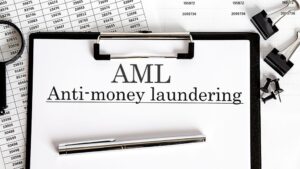Structuring effective AML/CTF governance requires a comprehensive understanding of international standards, continuous monitoring of high-risk transactions, and fostering cross-sector collaboration to address evolving threats in the financial landscape.
A sound governance structure is the foundation of an effective AML/CTF program. It will include the board of directors and senior management setting the tone at the top, hiring of a qualified chief AML/CTF officer, and properly resourcing the three lines of defense. In an organization such as a bank or a financial institution, the Board of Directors is primarily responsible for setting up a strong compliance culture and implementing the compliance program. AML/CTF programs are vital in identifying, disrupting, and preventing money laundering and terrorism financing.
The “tone at the top” is a public commitment at the organization’s highest levels to comply with AML/CTF requirements as part of its core mission and recognition that this is critical to the overall risk management framework of the bank.
To ensure appropriate oversight of the compliance culture, the Board of Directors forms a board-level sub-committee to periodically monitor the compliance practices and measures taken by the management.
The board of directors may delegate the responsibility to the board compliance committee or BCC. The members of the BCC periodically conduct compliance meetings, where significant compliance issues, breaches, and new regulatory requirements are reviewed and discussed.
The BCC ensures that a strong compliance culture and control environment is maintained. It provides oversight and guidance to the compliance committee and senior management to implement the compliance program and policies approved by the board. The management forms the set of processes, reporting lines, systems, and structures that provide the basis for carrying out regulatory requirements across the organization. The control environment relates to the commitment of management and employees to integrity and ethical values.
Structuring Effective AML/CTF Governance
Establishment of Appropriate Behaviors
For internal controls to be efficient, an appropriate control environment should demonstrate the following behaviors:
The board reviews policies and procedures periodically and ensures their compliance;
The board determines whether there is an audit and control system in place to periodically test and monitor compliance with internal control policies or procedures and to report to the board instances of non-compliance;
The board ensures the independence of internal and external auditors such that the internal audit directly reports to the audit committee of the board, which is responsible to the board, and that the external auditor interacts with the said committee and presents a management letter to the board directly;
The board ensures that appropriate remedial action has been taken when the instance of non-compliance is reported and that system has been improved to avoid recurring errors or mistakes;
Management information systems provide adequate information to the board so that the board can have access to records if the need arises; and
The board and management ensure communication of compliance policies down the line within the organization.
The board forms a sub-committee, known as the BCC, to provide strong oversight to the compliance committee and the management, to ensure effective and continued implementation of applicable regulatory requirements.
The BCC ensures the management implements the board-approved compliance program for effective compliance. The BCC forms a management-level compliance committee known as the Central Compliance Committee or CCC. The CCC works on behalf of the BCC to regularly review and provide appropriate feedback to the management and employees regarding the organization’s overall compliance profile.
The Management Compliance Committee or MCC comprises all the departmental heads as members of the MCC, and they meet periodically to discuss the compliance status of their respective departments. The Chief Compliance Officer, or CCO, serves as the BCC’s secretary. The CCO also prepares and presents the agenda of the BCC meeting before the BCC members before each periodic meeting.
The Money Laundering Reporting Officer, or MLRO, being part of the compliance function, serves as the second line of defense and works in coordination with the first line of defense. It includes the Business and Operation Managers who are responsible for establishing the business relationships and processing the transactions of the clients and customers. MLRO is mainly responsible for adopting the risk-based approach toward managing the AML and regulatory compliance-related roles and responsibilities.
As a best practice, the MLRO of a larger organization or business should not be directly involved in the business operations, receipt, transfer, or payment of funds. The appointed MLRO should also have independent oversight and be able to communicate directly with those parties who make decisions about the business, such as senior management or the board of directors.
Requirements of MLRO
An MLRO needs to:
Have the necessary authority and access to resources like client files or business information to trace processes to implement an effective compliance program and make any necessary decisions and changes;
Know the business’ functions and structure;
Have knowledge of the business sector’s ML/TF risks and vulnerabilities as well as ML/TF trends and typologies; and
Understand the business sector’s requirements under the Proceeds of Crime (Money Laundering) and Terrorist Financing Act or PCMLTFA and associated regulations.
The MLRO is mainly responsible to:
Ensure compliance with applicable AML/CTF and KYC laws, rules, regulations, and instructions;
Develop end-to-end compliance programs and all AML/KYC policies, procedures, methods, tools, etc., in the light of these guidelines and ensure/monitor/oversee their entity-wide implementation;
Determine the resources required to perform compliance roles and responsibilities professionally and of desired quality;
Ensure appropriate AML/KYC policies and processes are developed and implemented to ensure that all the customers are identified, screened, and verified before opening an account or establishing a business relationship with them;
Provide summary data and report findings on compliance issues to the board or its subcommittee and Customer Compliance Management or CCM periodically;
Report to the MCC and the BCC promptly on any material regulatory non-compliance, such as failures that may attract a significant penalty;
Ensure that customer accounts are regularly monitored to identify suspicious activities and transactions;
Review the compliance policies and procedures to ensure that AML, CTF, and KYC-related regulatory requirements are incorporated for meticulous compliance;
Coordinate with senior management to implement the overall compliance program;
Apprise the board of directors and senior management on AML/KYC initiatives;
Ensure that the employees are provided with AML/KYC training;
Informing the relevant authorities about financial crime information, suspicious actions, and individuals; and
Timely and accurately submit the Suspicious Activity Report or SAR to the relevant regulatory authority.
Who can become a MLRO?
The person appointed as MLRO by a company must have the approval of the Financial Services Authority (FSA). They must have received relevant training before applying to FSA, must be experienced and educated in the field of the company’s business and also experienced regarding AML/CTF compliance. It is required that they have knowledge of all recent regulations, rules, sanctions, markets, and AML/CTF procedures and that they attend all necessary credible courses for the respective field. FSA does not recommend a specified class, but in general courses with examinations are preferred.
Final Thoughts
An effective Anti-Money Laundering and Counter-Terrorism Financing (AML/CTF) program is pivotal to the integrity of financial institutions, and its foundation lies in a robust governance structure. At the helm of this governance, the board of directors and senior management play an instrumental role in setting the compliance tone and fostering a culture of adherence. The intricate architecture of compliance oversight, from board-level sub-committees like the BCC and CCC to frontline defenses like the MLRO, underscores the organization’s commitment to thwart money laundering and terrorism financing.
As gatekeepers, entities like MLRO are especially crucial, possessing a blend of regulatory knowledge, operational understanding, and proactive vigilance. Their role, sanctioned by bodies like the FSA, forms an indispensable layer in ensuring meticulous compliance and protecting the institution from financial malfeasance. In essence, the strength and efficacy of an AML/CTF program are a collaborative endeavor, anchored in sound governance and carried forward by dedicated compliance professionals.




